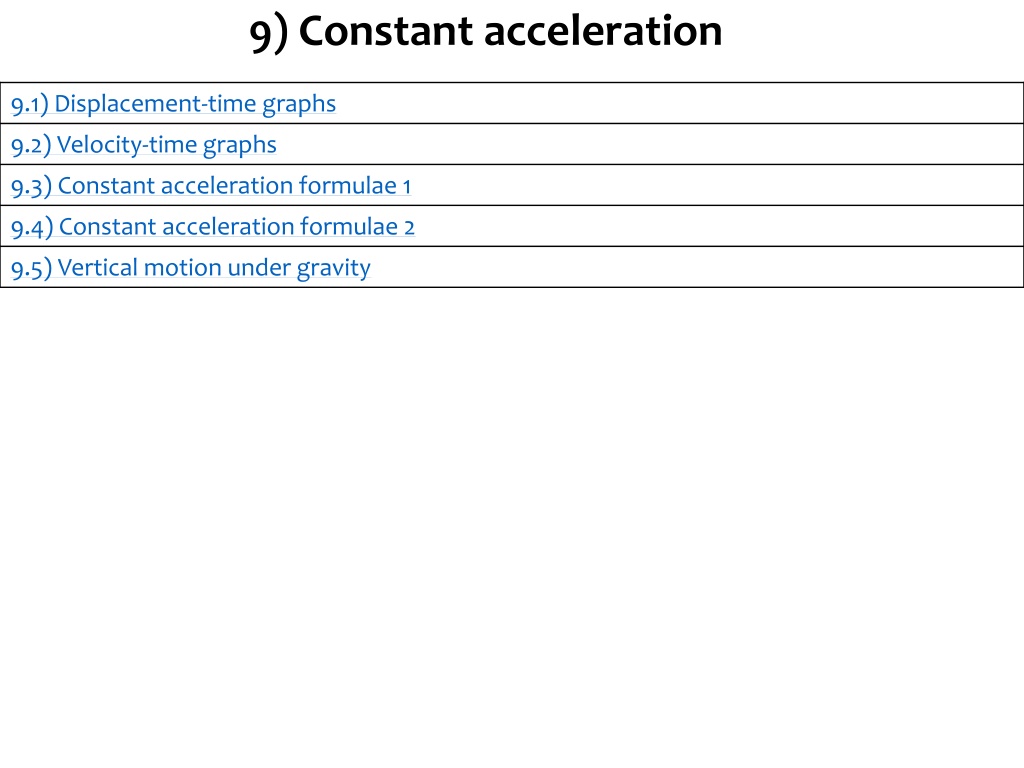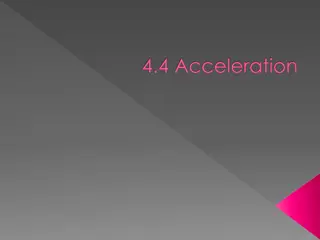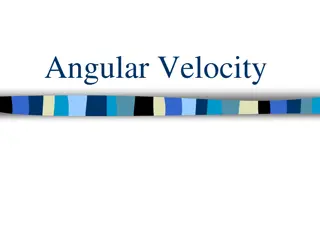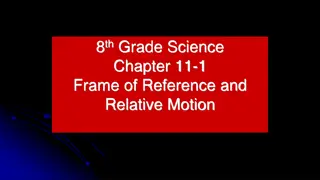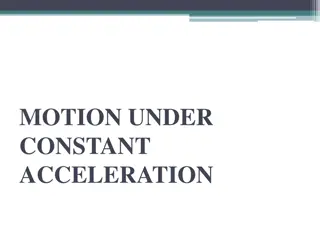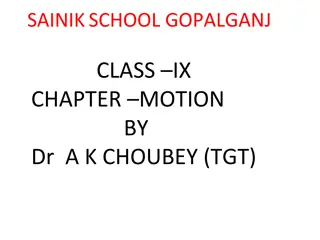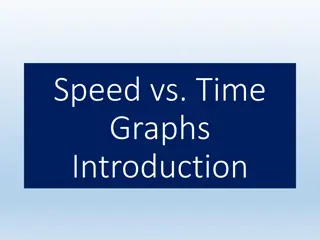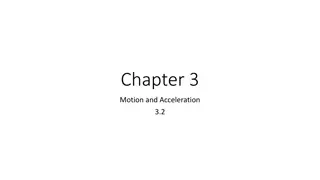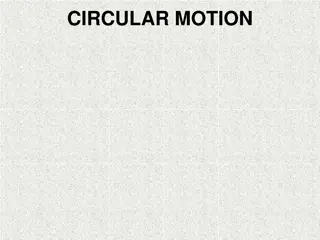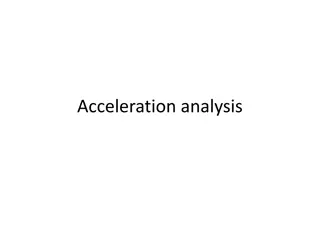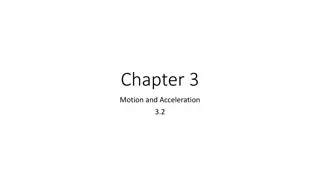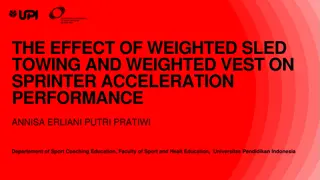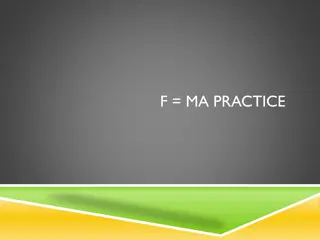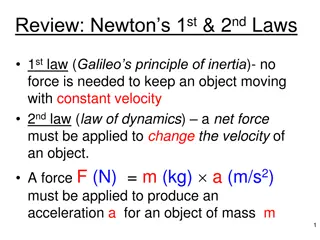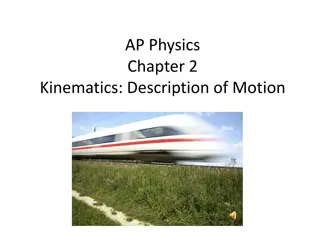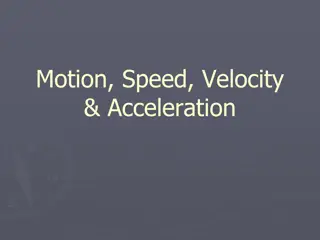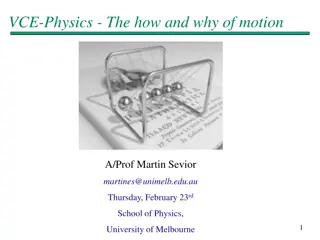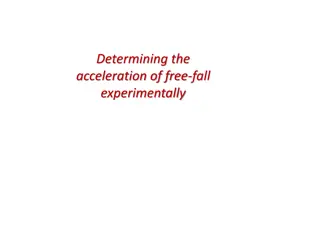Constant Acceleration in Motion Analysis
Displacement-time graphs, velocity-time graphs, formulas, and vertical motion under gravity in the context of constant acceleration. Includes worked examples to describe the motion of objects from graphs and analyze average velocities and speeds of cyclists in different scenarios.
Download Presentation

Please find below an Image/Link to download the presentation.
The content on the website is provided AS IS for your information and personal use only. It may not be sold, licensed, or shared on other websites without obtaining consent from the author. Download presentation by click this link. If you encounter any issues during the download, it is possible that the publisher has removed the file from their server.
E N D
Presentation Transcript
9) Constant acceleration 9.1) Displacement-time graphs 9.2) Velocity-time graphs 9.3) Constant acceleration formulae 1 9.4) Constant acceleration formulae 2 9.5) Vertical motion under gravity
Chapter CONTENTS 9.1) Displacement-time graphs
Your turn Worked example Describe the motion of each object from the displacement-time graph: Describe the motion of each object from the displacement-time graph: Object is accelerating Diagrams/Graphs used with permission from DrFrostMaths: https://www.drfrostmaths.com/
Your turn Worked example A cyclist rides in a straight line for 20 minutes. She waits for half an hour, then returns in a straight line to her starting point in 15 minutes. a) Work out the average velocity for each stage of the journey in km h-1. b) Write down the average velocity for the whole journey. c) Work out average speed for the whole journey. A cyclist rides in a straight line for 30 minutes. She waits for a quarter of an hour, then returns in a straight line to her starting point in 25 minutes. a) Work out the average velocity for each stage of the journey in km h-1. b) Write down the average velocity for the whole journey. c) Work out average speed for the whole journey. a) OA: 15 ?? 1 ; AB: 0 ?? 1 ; BC: 20 ?? 1 b) 0 c) 9.23 ?? 1 (3??) Diagrams/Graphs used with permission from DrFrostMaths: https://www.drfrostmaths.com/
Chapter CONTENTS 9.2) Velocity-time graphs
Your turn Worked example Describe the motion of each object from the velocity-time graph: Describe the motion of each object from the velocity-time graph: Object has constant acceleration. Velocity is increasing at a constant rate. Diagrams/Graphs used with permission from DrFrostMaths: https://www.drfrostmaths.com/
Your turn Worked example A cyclist is moving along a straight road for a period of 12 seconds. For the first 8 seconds, she moves at a constant speed of 6 m s-1. She then decelerates at a constant rate, stopping after a further 4 seconds. (a) Find the displacement from the starting point of the cyclist after this 12 second period. (b) Work out the rate at which the cyclist decelerates. A cyclist is moving along a straight road for a period of 21 seconds. For the first 6 seconds, she moves at a constant speed of 8 ?? 1. She then decelerates at a constant rate, stopping after a further 15 seconds. (a) Find the displacement from the starting point of the cyclist after this 21 second period. (b) Work out the rate at which the cyclist decelerates. a) 60 ? b) 1.5 ?? 2 Diagrams/Graphs used with permission from DrFrostMaths: https://www.drfrostmaths.com/
Your turn Worked example A particle moves along a straight line. The particle accelerates uniformly from rest to a velocity of 8 ms-1 in ? seconds. The particle then travels at a constant velocity of 8 ms-1 for 5? seconds. The particle then decelerates uniformly to rest in a further 40 s. (a) Sketch a velocity-time graph to illustrate the motion of the particle. Give then the total displacement of the particle is 600m. (b) find the value of ?. A particle moves along a straight line. The particle accelerates uniformly from rest to a velocity of 16 ?? 1 in ? seconds. The particle then travels at a constant velocity of 16 ?? 1 for 3? seconds. The particle then decelerates uniformly to rest in a further 4 s. (a) Sketch a velocity-time graph to illustrate the motion of the particle. Give then the total displacement of the particle is 592m. (b) find the value of ?. a) b) ? = 10 Diagrams/Graphs used with permission from DrFrostMaths: https://www.drfrostmaths.com/
Your turn Worked example A car is travelling along a straight horizontal road. The car takes 120 ? to travel between two sets of traffic lights which are 2145 ? apart. The car starts from rest at the first set of traffic lights and moves with constant acceleration for 30 ? until its speed is 22 ? ? 1. The car maintains this speed for ? seconds. The car then moves with constant deceleration, coming to rest at the second set of traffic lights. a) Sketch a speed-time graph for the motion of the car between the two sets of traffic lights b) Find the value of ? a) A car is travelling along a straight horizontal road. The car takes 60 ? to travel between two sets of traffic lights which are 1072.5 ? apart. The car starts from rest at the first set of traffic lights and moves with constant acceleration for 15 ? until its speed is 11 ? ? 1. The car maintains this speed for ? seconds. The car then moves with constant deceleration, coming to rest at the second set of traffic lights. a) Sketch a speed-time graph for the motion of the car between the two sets of traffic lights b) Find the value of ? b) ? = 75 Diagrams/Graphs used with permission from DrFrostMaths: https://www.drfrostmaths.com/
Your turn Worked example A car is travelling along a straight horizontal road. The car takes 120 ? to travel between two sets of traffic lights which are 2145 ? apart. The car starts from rest at the first set of traffic lights and moves with constant acceleration for 30 ? until its speed is 22 ? ? 1. The car maintains this speed for ? seconds. The car then moves with constant deceleration, coming to rest at the second set of traffic lights. a) Sketch a speed-time graph for the motion of the car between the two sets of traffic lights b) Find the value of ? a) A car is travelling along a straight horizontal road. The car takes 60 ? to travel between two sets of traffic lights which are 1072.5 ? apart. The car starts from rest at the first set of traffic lights and moves with constant acceleration for 15 ? until its speed is 11 ? ? 1. The car maintains this speed for ? seconds. The car then moves with constant deceleration, coming to rest at the second set of traffic lights. a) Sketch a speed-time graph for the motion of the car between the two sets of traffic lights b) Find the value of ? b) ? = 75 Diagrams/Graphs used with permission from DrFrostMaths: https://www.drfrostmaths.com/
Your turn Worked example A car is travelling along a straight horizontal road. The car takes 120 ? to travel between two sets of traffic lights which are 2145 ? apart. The car starts from rest at the first set of traffic lights and moves with constant acceleration for 30 ? until its speed is 22 ? ? 1. The car maintains this speed for ? seconds. The car then moves with constant deceleration, coming to rest at the second set of traffic lights. A car is travelling along a straight horizontal road. The car takes 60 ? to travel between two sets of traffic lights which are 1072.5 ? apart. The car starts from rest at the first set of traffic lights and moves with constant acceleration for 15 ? until its speed is 11 ? ? 1. The car maintains this speed for ? seconds. The car then moves with constant deceleration, coming to rest at the second set of traffic lights. A motorcycle leaves the first set of traffic lights 15 s after the car has left the first set of traffic lights. The motorcycle moves from rest with constant acceleration, and passes the car at the point ? which is 495 ? from the first set of traffic lights. When the motorcycle passes the car, the car is moving with speed 11 ?? 1 A motorcycle leaves the first set of traffic lights 10 s after the car has left the first set of traffic lights. The motorcycle moves from rest with constant acceleration, and passes the car at the point ? which is 990 ? from the first set of traffic lights. When the motorcycle passes the car, the car is moving with speed 22 ?? 1 c) Find the time it takes for the motorcycle to move from the first set of traffic lights to the point ? c) Find the time it takes for the motorcycle to move from the first set of traffic lights to the point ? c) 50 seconds
Your turn Worked example A car is moving along a straight horizontal road. At time ? = 0, the car is moving with speed 20 ?? 1 and is at the point ?. The car maintains this speed for 25 ?. The car then moves with constant deceleration 0.4 ?? 2, reducing its speed from 20 ?? 1 to 8 ?? 1. The car then moves with constant speed 8 ?? 1 for 60 ?. The car then moves with constant acceleration until it is moving with speed 20 ?? 1at the point ?. Given that the distance from ? to ? is 1960 ?, find the time taken for the car to move from ? to ? A car is moving along a straight horizontal road. At time ? = 0, the car is moving with speed 10 ?? 1 and is at the point ?. The car maintains this speed for 50 ?. The car then moves with constant deceleration 0.6 ?? 2, reducing its speed from 10 ?? 1 to 4 ?? 1. The car then moves with constant speed 4 ?? 1 for 30 ?. The car then moves with constant acceleration until it is moving with speed 10 ?? 1at the point ?. Given that the distance from ? to ? is 980 ?, find the time taken for the car to move from ? to ? 155 seconds
Your turn Worked example A cyclist is travelling along a straight road. She accelerates at a constant rate from a velocity of 4 ?? 1 to a velocity of 7.5 ?? 1 in 40 seconds. Find: (a) the distance she travels in these 40 seconds (b) her acceleration in these 40 seconds. a) 230 ? b) 0.0875 ?? 2 A cyclist is travelling along a straight road. She accelerates at a constant rate from a velocity of 5 ?? 1 to a velocity of 7.4 ?? 1 in 50 seconds. Find: (a) the distance she travels in these 50 seconds (b) her acceleration in these 50 seconds.
Your turn Worked example A particle moves in a straight line from a point ? to a point ? with a constant deceleration 1.5 ?? 2. The velocity of the particle at ? is 8 ?? 1 and the velocity of the particle at B is 2 ?? 1. Find: (a) the time taken for the particle to move from ? to ?. (b) the distance from ? to ?. A particle moves in a straight line from a point ? to a point ? with a constant deceleration 3 ?? 2. The velocity of the particle at ? is 16 ?? 1 and the velocity of the particle at B is 4 ?? 1. Find: (a) the time taken for the particle to move from ? to ?. (b) the distance from ? to ?. After reaching ? the particle continues to move along the straight line with constant deceleration 1.5 ?? 2. The particle is at the point ? 6 seconds after passing through the point ?. Find: (c) the velocity of the particle at ?. (d) The distance from ? to ?. After reaching ? the particle continues to move along the straight line with constant deceleration 3 ?? 2. The particle is at the point ? 12 seconds after passing through the point ?. Find: (c) the velocity of the particle at ?. (d) The distance from ? to ?. a) 4 s b) 20 ? c) 1 ?? 1 in the direction ?? d) 21 ?
Your turn Worked example A car moves from traffic lights along a straight road with constant acceleration. The car starts from rest at the traffic lights and 30 seconds later the car passes a speed-trap where it is registered as travelling at 45 ?? 1. Find: (a) the acceleration of the car (b) the distance between the traffic lights and the speed- trap. a) 5 b) 187.5 ? A car moves from traffic lights along a straight road with constant acceleration. The car starts from rest at the traffic lights and 20 seconds later the car passes a speed-trap where it is registered as travelling at 54 ?? 1. Find: (a) the acceleration of the car (b) the distance between the traffic lights and the speed- trap. 12 ?? 2= 0.417 ?? 2 (3 sf)
Your turn Worked example ?+? ?+? Use the equations ? = ? + ?? and ? = ? to derive: Use the equations ? = ? + ?? and ? = ? to derive: 2 2 ?2= ?2+ 2?? ? = ?? +1 2??2 Shown ? = ?? 1 2??2
Your turn Worked example A particle is moving along a straight line from ? to ? with constant acceleration 5 ?? 2. The velocity of the particle is 3 ?? 1 in the direction ??. The velocity of the particle at ? is 18 ?? 1 in the same direction. Find the distance from ? to ?. 31.5 ? A particle is moving along a straight line from ? to ? with constant acceleration 3 ?? 2. The velocity of the particle is 5 ?? 1 in the direction ??. The velocity of the particle at ? is 81 ?? 1 in the same direction. Find the distance from ? to ?.
Your turn Worked example A particle is moving in a straight horizontal line with constant deceleration 4 ms-2. At time ? = 0 the particle passes through a point ? with speed 13 ms-1 travelling towards a point ?, where ?? = 20 m. Find: (a) the times when the particle passes through ? (b) the value of ? when the particle returns to ?. A particle is moving in a straight horizontal line with constant deceleration 6 ms-2. At time ? = 0 the particle passes through a point ? with speed 23 ms-1 travelling towards a point ?, where ?? = 40 m. Find: (a) the times when the particle passes through ? (b) the value of ? when the particle returns to ?. a) ? = 2.5 s, ? = 4 s b) ? = 6.5 s
Your turn Worked example A particle is moving in a straight horizontal line with constant deceleration 4 ms-2. At time ? = 0 the particle passes through a point ? with speed 13 ms-1. Find the total distance travelled by the particle between when it first passes ? and returns to ? A particle is moving in a straight horizontal line with constant deceleration 6 ms-2. At time ? = 0 the particle passes through a point ? with speed 23 ms-1. Find the total distance travelled by the particle between when it first passes ? and returns to ? 42.25 ?
Your turn Worked example Two particles ? and ? are moving along the same straight horizontal line with constant accelerations 6 and 8?? 2 respectively. At time ? = 0, ? passes through a point ? with speed 10 ?? 1. One second later ? passes through ? with speed 5 ?? 1, moving in the same direction as ?. a) Find the value of ? where the particles meet. b) Find the distance of ? from the point where the particles meet. a) ? = 13.1 s (3 sf) b) 644 m (3 sf) Two particles ? and ? are moving along the same straight horizontal line with constant accelerations 2 and 4?? 2 respectively. At time ? = 0, ? passes through a point ? with speed 12 ?? 1. One second later ? passes through ? with speed 6 ?? 1, moving in the same direction as ?. a) Find the value of ? where the particles meet. b) Find the distance of ? from the point where the particles meet.
Your turn Worked example A particle moves in a straight horizontal line with constant acceleration from A to B, then B to C. AB = 4 ?? and BC = 12 ??. It takes 2 hours from A to B and 3 hours from B to C. Find: a) The acceleration of the particle b) The particle s speed as it passes A A particle moves in a straight horizontal line with constant acceleration from A to B, then B to C. AB = 3 ?? and BC = 12 ??. It takes 2 hour from A to B and 4 hours from B to C. Find: a) The acceleration of the particle b) The particle s speed as it passes A a) 0.8 ?? 2= 6.1728 10 5 ?? 2 (3 sf) b) 1.2 ?? 1= 0.333 ?? 1 (3 sf)
Chapter CONTENTS 9.5) Vertical motion under gravity
Your turn Worked example A book falls off the top shelf of a bookcase. The shelf is 1.4 m above a wooden floor. Find: (a) the time the book takes to reach the floor, (b) the speed with which the book strikes the floor. A book falls off the top shelf of a bookcase. The shelf is 2.8 m above a wooden floor. Find: (a) the time the book takes to reach the floor, (b) the speed with which the book strikes the floor. a) 0.53 ? b) 5.2 ?? 1
Your turn Worked example A ball is projected vertically upwards, from a point ? which is 7m above the ground, with speed 21 ms- 1. Find (a) the greatest height above the ground reached by the ball, (b) the time of flight of the ball A ball is projected vertically upwards, from a point ? which is 5m above the ground, with speed 15 ms- 1. Find (a) the greatest height above the ground reached by the ball, (b) the time of flight of the ball a) 30 ? (2 sf) b) 4.6 ? (2 sf)
Your turn Worked example A ball is projected vertically upwards from ground level at a speed of 20 ms-1. Determine the amount of time the ball is at least 10m above ground level. A ball is projected vertically upwards from ground level at a speed of 40 ms-1. Determine the amount of time the ball is at least 20m above ground level. 2.9 ? (2 sf)
Your turn Worked example A ball is projected vertically upwards with initial speed of 15 ?? 1. It hits the ground 5 ? later. Find the height above the ground from which the ball was thrown. 47.5 ? A ball is projected vertically upwards with initial speed of 20 ?? 1. It hits the ground 5 ? later. Find the height above the ground from which the ball was thrown.
Your turn Worked example A stone is thrown vertically upward from a point which is 5 ? above the ground with speed 8 ?? 1. Find: a) The time of flight of the stone b) The total distance travelled by the stone a) 2.1 s (2 sf) b) 12 ? (2 sf) A stone is thrown vertically upward from a point which is 8 ? above the ground with speed 5 ?? 1. Find: a) The time of flight of the stone b) The total distance travelled by the stone
Your turn Worked example Ball ? falls vertically from rest from the top of a tower 63 ? high. At the same time as ? begins to fall, another ball ? is projected vertically upwards from the bottom of the tower with speed 21 ?? 1. The balls collide. Find the distance to the point where the balls collide from the bottom of the tower. 19 ? (2 sf) Ball ? falls vertically from rest from the top of a tower 48 ? high. At the same time as ? begins to fall, another ball ? is projected vertically upwards from the bottom of the tower with speed 24 ?? 1. The balls collide. Find the distance to the point where the balls collide from the bottom of the tower.
Your turn Worked example At time ? = 0, two balls ? and ? are projected vertically upwards. Ball ? is projected upwards with speed 2 ?? 1 from a point 50 ? above the horizontal ground. Ball ? is projected vertically upwards from the ground with speed 20 ?? 1. The balls are modelled as particles moving freely under gravity. Find the time and the height at which the balls are at the same vertical height. At time ? = 0, two balls ? and ? are projected vertically upwards. Ball ? is projected upwards with speed 3 ?? 1 from a point 40 ? above the horizontal ground. Ball ? is projected vertically upwards from the ground with speed 30 ?? 1. The balls are modelled as particles moving freely under gravity. Find the time and the height at which the balls are at the same vertical height. ? = 2.8 ? (2 sf) = 18 ? (2 sf)
Your turn Worked example A ball is released from rest at a point which is 10 ? above a wooden floor. Each time the ball strikes the floor, it rebounds with 3 which it strikes the floor. Find the greatest height above the floor reached by the ball: a) The first time it rebounds from the floor b) The second time it rebounds from the floor. A ball is released from rest at a point which is 20 ? above a wooden floor. Each time the ball strikes the floor, it rebounds with 2 which it strikes the floor. Find the greatest height above the floor reached by the ball: a) The first time it rebounds from the floor b) The second time it rebounds from the floor. 4 of the speed with 3 of the speed with a) 5.6 ? (2 sf) b) 3.2 ? (2 sf)
